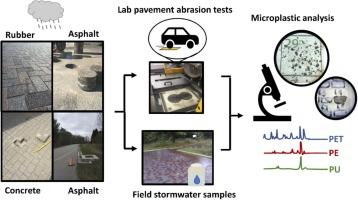Pavement wear generates microplastics in stormwater runoff
IF 12.2
1区 环境科学与生态学
Q1 ENGINEERING, ENVIRONMENTAL
引用次数: 0
Abstract
Tire and road wear particles are a major source of microplastics to urban stormwater. They are composed of hetero-aggregates of abraded tire and pavement particles that are difficult to distinguish. While tire wear is a known source of microplastics, little is known on the contribution of pavement wear. This two-year field study with complementary lab testing evaluates the effects of pavement degradation on microplastic generation in stormwater from different pavement types: asphalt, concrete, and recycled rubber pavers. Pavement specimens from each site were collected and underwent degradation testing. We directly demonstrated that pavement wear is a source of microplastics in stormwater separate from tire wear. We showed that the rubber pavement released the most microplastics in lab testing, suggesting that the formulation of such novel recycled-tire pavers must undergo thorough testing before wide application. The asphalt pavement was the most susceptible to rutting and released the most microplastics in the field, including a large proportion of tire wear particles. Both land-use and pavement surface characteristics influenced microplastic generation. These results demonstrate the need to consider microplastic generation during pavement material selection and mitigate the spread of microplastics from pavement wear to nearby environments.

路面磨损在雨水径流中产生微塑料
轮胎和路面磨损颗粒是城市雨水中微塑料的主要来源。它们由难以区分的磨损轮胎和路面颗粒的异质聚集体组成。众所周知,轮胎磨损是微塑料的一个来源,但对路面磨损的贡献却知之甚少。这项为期两年的实地研究结合实验室补充测试,评估了路面降解对不同类型路面(沥青、混凝土和再生橡胶摊铺机)雨水中微塑料生成的影响。我们收集了每个地点的路面样本,并对其进行了降解测试。我们直接证明,路面磨损是雨水中微塑料的来源之一,与轮胎磨损无关。我们在实验室测试中发现,橡胶路面释放的微塑料最多,这表明这种新型回收轮胎铺路材料的配方在广泛应用之前必须经过全面测试。沥青路面最容易出现车辙,在实地测试中释放的微塑料也最多,其中包括很大一部分轮胎磨损颗粒。土地使用和路面表面特征都会影响微塑料的生成。这些结果表明,在选择路面材料时需要考虑微塑料的产生,并减少微塑料从路面磨损向附近环境的扩散。
本文章由计算机程序翻译,如有差异,请以英文原文为准。
求助全文
约1分钟内获得全文
求助全文
来源期刊

Journal of Hazardous Materials
工程技术-工程:环境
CiteScore
25.40
自引率
5.90%
发文量
3059
审稿时长
58 days
期刊介绍:
The Journal of Hazardous Materials serves as a global platform for promoting cutting-edge research in the field of Environmental Science and Engineering. Our publication features a wide range of articles, including full-length research papers, review articles, and perspectives, with the aim of enhancing our understanding of the dangers and risks associated with various materials concerning public health and the environment. It is important to note that the term "environmental contaminants" refers specifically to substances that pose hazardous effects through contamination, while excluding those that do not have such impacts on the environment or human health. Moreover, we emphasize the distinction between wastes and hazardous materials in order to provide further clarity on the scope of the journal. We have a keen interest in exploring specific compounds and microbial agents that have adverse effects on the environment.
 求助内容:
求助内容: 应助结果提醒方式:
应助结果提醒方式:


